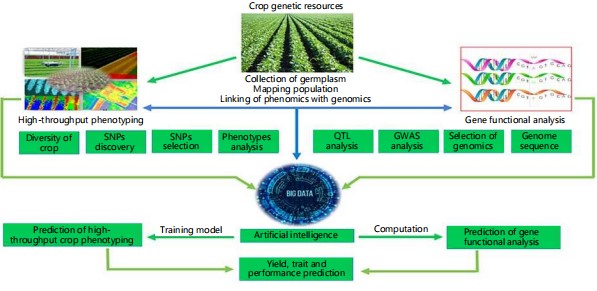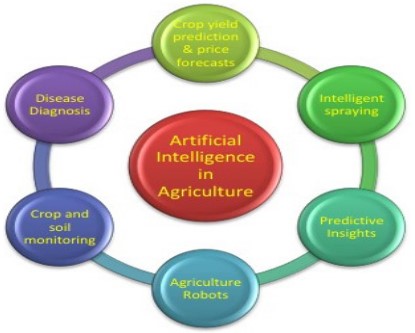Future of Farming: A Review of Artificial Intelligence Applications in Agricultural Production and Processing
| Received 01 Dec, 2024 |
Accepted 17 Feb, 2025 |
Published 31 Mar, 2025 |
The growing global population and decrease in the availability of agricultural labor demand a more efficient approach to global supply chains. Artificial Intelligence (AI) defines human intelligence in a manner that enables machines to replicate and perform tasks ranging from simple to highly complex. Recent advances in electronics offer vast opportunities for research, development, and innovation in agriculture. Consequently, there is continual scope to introduce novel technologies such as robotic platforms, sensors for detecting plant health, robotic harvesters, unmanned aerial vehicles, and advanced techniques for mapping soil nutrients, which can change the phase of agriculture. The papers therefore aim to review the overview and implications of artificial intelligence in agricultural production and processing. Artificial Intelligence (AI) has been increasingly used in agriculture recently. The agricultural sector encounters various challenges to enhance its productivity, such as inadequate soil management, pests, and diseases, the need for handling big data, low yields, and a gap in knowledge between farmers and technology. A special focus is laid on the strengths and limitations of the AI application and the way to utilize expert systems for higher productivity. The core benefits of AI in agriculture include its adaptability, efficiency, precision, and cost-effectiveness.
INTRODUCTION
The world's population is assumed to be nearly 10 billion by 2050 and boosting agricultural production is the main object1. Therefore, ensuring food security to feed a dynamic population is a top priority for nations worldwide2. At present, about 37.7% of the total land surface is used for crop production. Agriculture plays a vital role in the economic growth of developed countries and contributes vigorously to the economies of developing countries. Improvement in the agricultural area will promote rural development, which in turn will drive rural development and ultimately lead to structural changes3,4.
Agricultural productivity has increased considerably over the years due to growth, largely assisted by mechanization and automation5. However, in the last two decades, it has expanded to include the processing, production, marketing, and distribution of crops and livestock products. Besides agriculture facing a lack of skilled workers, these challenges can be mitigated using artificial intelligence technologies like robotics and automation. These innovations positively affect farmers’ quality of life and appeal to younger generations by reducing laborious tasks in difficult conditions6.
Artificial Intelligence (AI) is a new technology that is being used in agriculture. AI-driven tools and machinery have elevated the agricultural industry to a new level. According to the previous study of Wang et al.7 these technologies have improved agricultural productivity and supported real-time monitoring, harvesting, processing, and selling. The modern technologies of automated systems using agricultural robots and drones have made a tremendous contribution in the agro-based sector. Advanced computer-based systems are also designed to assess key factors such as weed detection, yield estimation, crop quality, and more8.
Due to the growing global population, there is a growing shortage of land, water, and resources to sustain the demand-supply chain. The weather changes from season to season, the price of farming materials fluctuates, soil degradation, crop failure, weed suffocation, pest damage, and climate variation. The issue of labor challenge for farm practices in line with expensive labor costs is also a main problem for farmers. So, farmers around the world must cope with these uncertainties. So, farmers need to adopt an artificial intelligence approach and become more efficient in their application in agriculture to increase productivity. The study, therefore, aimed to review the overview and implication of artificial intelligence in agricultural production and processing for crop improvement.
AI TECHNOLOGIES IN AGRICULTURAL PRODUCTION AND PROCESSING
Several issues facing agriculture include the demand for increased labor and the effects of climate change. The agriculture sector may be able to overcome these obstacles by utilizing digital technologies, such as AI tools. Several AI technologies for agriculture are available to improve productivity and guarantee long-term success.
Precision agriculture: It is the method of applying the proper amount of input (fertilizer, pesticide, water, etc.) at the right location at the right time to enhance production, decrease input, and/or protect the environment. Precision agriculture is a farming management approach that enhances agricultural production sustainability by monitoring, measuring, and adapting to temporal and spatial variability (www.ispag.org.), that is applied in both crops and livestock production. Precision agriculture often uses technology to automate farming practices and improve their performance, diagnosis, and decision-making9. The objective of precision agriculture research is to describe a decision support system for whole farm management to optimize incomes on inputs while sustaining resources10,11.
Precision agriculture is the practice of applying the right number of inputs (such as fertilizers, pesticides, and water) at the optimal location and time to improve production, reduce input costs, and/or protect the environment12. Precision agriculture improves resource distribution efficiency and general farm management effectiveness13. Through real resource utilization and variability management, precision agriculture bargains an archetype shift towards a safe, sustainable approach and offers frequent benefits in terms of profitability, productivity, sustainability, crop quality, environmental protection, and rural economic development. The success of precision agriculture lies in its ability to effectively utilize and analyze spatial and temporal data to assess, manage, and evaluate crop production, making it a fundamental principle for sustainable soil and crop management in the modern era14.
Robotics in agriculture: The mechanization and modernization of agricultural tasks are an essential step to addressing population growth. The researcher of Khadatkar et al.15 emphasized the available robotics systems for various farm operations of field crops and horticulture. Agriculture robotics systems are now being developed to operate in the field and assist farmers with tiresome jobs, pushing agriculture systems to new technology.
Agricultural robots are a new technology used for agriculture. The main area of application of robots in agriculture is at the harvesting stage. Fruit-picking robots, drivers, fewer tractors or sprayers, and sheep-shearing robots are planned to change individual labor. Robots can be used for other horticultural tasks such as pruning, weeding, spraying, and monitoring. Robots can also be used in livestock applications such as automatic milking, washing, and castrating. Robots like these have many profits for the agricultural industry, including a high uniformity of fresh produce and lower manufacturing costs16.
Robotic trans-planters utilize computer graphics or machine vision systems to perform transplanting tasks14. These machines typically include a robotic arm for picking up seedlings, a path manipulator, and an end-effector17,18. Intercultural operations like weeding are carried out using mechanical weeders or chemical spraying. Robotic weeders employ vision-based systems to detect weeds, guide the weeder, and remove weeds mechanically19-21. A robotic patch spraying system was developed for the precise application of herbicides22. Efficient harvesting involves tasks like fruit selection and detachment. Most robotic harvesters for fruits are designed to grasp the fruit with grippers and detach it based on factors such as shape, size, color, and texture7,23.
AI APPLICATIONS IN AGRICULTURAL PRODUCTION AND PROCESSING
Application of AI in crop breeding: The agriculture sector faces significant pressure to enhance crop productivity and maximize yields in response to global population growth, projected to reach 10 billion by 20501. Two strategies have emerged to address the looming food shortages: adopting innovative techniques and leveraging technology to boost productivity on existing farmland or expanding land use and implementing large-scale farming. The current agricultural landscape is evolving in various innovative directions due to multiple challenges hindering targeted farming production, such as limited land availability, labor shortages, climate change, environmental concerns, and declining soil fertility. The AI-driven plant breeding has been recognized as a pivotal solution in the pursuit of sustainable agriculture and food security24.
Breeders utilize AI to simulate numerous genetic combinations, accurately forecasting their impact on traits such as crop yield, resilience, nutritional value, and more. To create high-yield, disease-resistant, and nutrient-rich crops, researchers can use this predictive model to intentionally breed the most promising combinations. Some possibilities exist for AI technologies to help crop breeding.
Genomic selection: The AI can analyze large-scale genomic data to identify genetic markers associated with desired traits such as yield, disease resistance, and nutritional content (Fig. 1). Breeders can accelerate the breeding process by choosing plants that exhibit the most favorable characteristics for further crop improvement. Recent advancements in genetic trait assessment and prediction include the development of DeepSea and DeepBind models25.
Predictive modeling: The AI may create prediction models that mimic how distinct genetic combinations would manifest in various environments. This saves time and money by enabling breeders to forecast how various crop varieties would perform in various environments without conducting in-depth field testing.
Phenotyping: The phenotyping process, involving the measurement and analysis of observable plant traits, can be automated and improved through AI. The AI-powered sensors and imaging technologies can accurately detect characteristics such as plant height, leaf area, and flowering time, facilitating rapid phenotyping of large plant populations26.

|
Accelerated breeding cycles: The AI aids breeders in shortening the breeding cycle and accelerating the release of new crop varieties by hastening the analysis of genetic data and predicting the performance of different crop types. This capability helps in tackling emerging challenges such as evolving pest and disease threats and the impacts of climate change.
Precision breeding: The AI plays a crucial role in precision breeding methods such as gene editing and CRISPR/Cas9 technologies by identifying target genes and predicting the outcomes of specific genetic changes. This technology guides genetic modifications in precision breeding, allowing researchers to access extensive data to precisely identify adjustments needed to eliminate undesired traits or enhance desired ones quickly and accurately25.
Weather forecasting and environmental protection: Weather is a major factor in agriculture planning and decision-making. Weather forecasting often uses several artificial intelligences. Supervised machine learning techniques, such as random forest, support vector machine (SVM), and neural networks, can be used to analyze historical data and anticipate future conditions based on patterns and trends. Random Forest has been used in weather forecasting because it can handle high-dimensional data and non-linear relationships27.
Artificial intelligence technology may allow farmers to get meteorological data, which would be helpful for timely sowing, harvesting, spraying, and other agronomic practices, increasing crop yield and profits by decreasing crop hazards. Forecasts of the weather can also be useful for managing pests, practicing on time, and taking preventative measures to lower input costs and yield loss. Farmers can use price forecasting to get a clear idea of crop prices in the coming weeks, allowing them to maximize profit. The AI algorithms can analyze large data sets and complex patterns to make highly accurate weather predictions. This accuracy is crucial for planning and proactive network management28. The AI can assist in resource allocation by predicting localized weather conditions, ensuring that resources are allocated to areas where they are most needed29.
The AI allows for more efficient ways to produce, harvest, and sell crop products, as well as a focus on inspecting defective crops and improving agricultural practices for eco-friendly crop production. The AI provides us with more accurate data about insect pest infestations, diseases, and weeds, as well as various management methods. The AI methods based on robotics, computer vision, and machine learning could assist farmers in spraying chemicals only where the pests are, reducing the use of chemical substances sprayed on the entire area. Environmental protection through pesticide reduction is a major functional advantage of AI technology. Therefore, AI technology assists farmers in pest control and pesticide residue reduction30.
Soil health monitoring: Today, to meet the growing demand for food, healthy soil is important. However, we are unable to identify the precise soil properties for each crop using a conventional approach. The AI and machine learning (ML) technologies have made it possible to track soil characteristics in farms, such as quality, fertility, microorganism, and nutrient deficiency as well as flora pattern, either through image capture with a camera recognition tool or by using a deep learning-based tool. In contrast to visual perception, AI can monitor crop health, forecast yield accurately, and detect crop malnutrition more precisely and quicker than the conventional method by analyzing and interpreting the available data. AI models can aware farmers to problems, so they can respond right away30.
Soil is the basis for world agriculture and food production, and it is regarded as an essential resource for living things. Unfortunately, determining soil quality can be difficult due to geographical limitations and a lack of scientific resources. Farmers can now discover a potential nutrient deficiency in soil quality by using AI technology, specifically electronic algorithms developed for deep learning. The AI plays a crucial role in soil quality analysis and the wide agricultural sector by engaging in the generalization, analysis, and processing of data obtained from diverse monitoring devices. Additionally, AI systems provide recommendations and ideas based on the analyzed data. Artificial Intelligence in soil quality monitoring technologies can aid in the protection and conservation of soil quality by allowing for the faster and safer processing of massive volumes of data gathered during physical soil sampling and remote imaging.
Application of AI in disease identification, monitoring, and pest management: The adoption of artificial intelligence technology has brought about a significant transformation in how diseases are identified, monitored, and pests managed in agriculture31. The AI algorithms employed for disease identification leverage various data sources such as multispectral imagery, spectral reflectance, and environmental sensor data32,33. These algorithms employ advanced machine learning techniques like convolutional neural networks (CNNs) and recurrent neural networks (RNNs) to detect subtle patterns and anomalies associated with diseases33,34.
The AI technologies critically improve pest control strategies by educating the application of control methods and reducing their environmental impact. The AI-powered decision support systems consider factors like pest life cycles, habitat preferences, weather conditions, and ecological interactions33. The AI algorithms integrate expert knowledge with data-driven awareness to propose targeted interventions that address specific pest issues. This method decreases reliance on broad-spectrum insecticides and mitigates harm to non-target organisms35.
The agricultural production supply chain is an extremely complex process. The AI transforms how crops are produced, distributed, and consumed. Researchers utilize AI technology to offer visions and recommendations on various agricultural activities within the food supply chain, such as crop rotation planning, planting seasons, water and nutrient management, pest and disease control, harvesting, food marketing, product distribution, and food security36. Traditional methods of monitoring plant health are labor-intensive and time-consuming. Using AI is an effective way to monitor and identify potential plant health problems or nutrient deficiencies in the soil. With the help of in-depth study, applications are developed to analyze crop health patterns in agriculture. Such AI-enabled applications are useful for better understanding, soil health, pest pests, and plant diseases37.

|
Harvest and post-harvest techniques: Harvesting involves actions such as cutting, picking, and digging to collect the valuable parts of plants. However, post-harvest losses, particularly in horticultural produce like tomatoes, remain a pervasive issue throughout the entire post-harvest value chain, largely due to the varying traditional knowledge and equipment, often operated manually, across different communities38. Post-harvest methods focus on enhancing the quality of agricultural products during storage, processing, packaging, transportation, and marketing. Harvesting is labor-intensive and tedious, which makes it costly and time-consuming, especially as manpower becomes scarce. Therefore, the automation of harvesting is seen as crucially important6.
Crop harvesting requires a lot of work and effort. The AI-based computer vision models help observe and estimate crop growth maturity without having to hire more people. A variety of Agri-bots have already been developed to automate harvesting to decrease losses, costs, environmental effects, and food waste. The AI-powered tools outperform human agricultural workers in terms of speed, difficulty, and accuracy. A significant portion of that work is now being handled by AI with ease and remarkable efficiency.
The harvesting of high-value crops largely depends on skilled and seasonal agricultural workers39. Additionally, a smart camera utilizes machine vision technology to inspect and grade food products based on quality. They employed an evolutionary learning process to simplify and enhance the visual inspection of food items, enabling automatic learning from training images and improving performance with boosting techniques40.
Advancements in technology focused on precise harvesting tasks, such as gathering fruit from trees or vegetables like chili peppers, represent a key area for advanced farms. Engineers are currently developing specialized robotic systems equipped with sophisticated cameras and algorithms. These technologies can detect color, shape, and precise locations to assess ripeness. These innovations are just a glimpse of the numerous robotic designs set to revolutionize harvesting, gradually replacing human labor. Enhanced by robust IoT systems, these agricultural robots (AG-bots) could autonomously monitor fields, use sensors to inspect plants, and harvest crops when they reach optimal ripeness6 shown in Fig. 2.
Environmental and economic impact of AI in agriculture: The AI is pivotal in promoting sustainable agriculture by opening the way for eco-friendly practices. Nevertheless, if unregulated, AI could also pose environmental risks. Some of the adverse environmental impacts of AI in agriculture include.
Researchers from the University of Massachusetts Amherst analyzed various natural language processing (NLP) training models to estimate their energy consumption and electricity costs during training. Their findings revealed that training an AI model resulted in approximately 300,000 kg of CO2 emissions, which is very significant to the degradation of the environment over time3. According to research conducted by the Open-AI lab in 2018, the carbon emissions from training large AI models have been doubling approximately every 3.4 months since 201241. It is evident that powering AI and IoT technologies demands a substantial amount of energy, and relying on fossil fuels for this purpose contributes to environmental pollution through advanced robotics and AI solutions.
The IoT sensors and agricultural robots have low battery demands and steady power needs, there could be a rise in greenhouse gas emissions and other issues related to global warming42. The long operational hours of these agricultural robots mean that the energy consumption of AI machines over their lifespan becomes significant, contributing to environmental impact. The small size of the seed poses problems during sowing, and indirectly during weeding and threshing. At sowing, the very small seed size makes it difficult to control population density, and distribution and makes it difficult to use mechanical planters. So, Different AI-related technologies are important for increasing the size of crops for proper management42. Studies indicate that the use of heavy machinery can cause permanent damage to soil, leading to a chain reaction of increased land pollution, erosion, loss of nutrients and pesticides, and reduced agricultural productivity. This harmful impact, known as soil compaction, occurs when the soil's pore structure and density are compromised over time, often resulting in irreversible degradation.
CHALLENGES AND OPPORTUNITIES
Many individuals view AI as relevant only to the digital world, assuming it has no relevance to physical farming tasks due to a lack of understanding about tools. This misconception often results in the slow adoption of AI across the agricultural sector, particularly among those in non-tech-related fields who may not fully grasp how AI functions. Despite numerous advancements in agriculture over time, many farmers remain more familiar with traditional methods and have limited experience with AI technology in their projects.
Apart from insufficient knowledge and experience, the agricultural sector generally lacks the necessary infrastructure to support AI works. Even farms equipped with some technology may encounter obstacles in advancing further. Infrastructure poses a challenge for Ag-Tech providers and software companies as well. One effective approach to overcoming this obstacle is by gradually introducing farmers to technology, starting with simple solutions like an agricultural trading platform. As farmers become comfortable with these basic tools, providers can progressively introduce more advanced features and technologies.
The AI is still developing; technology will have constraints. Accurate models rely on diverse and high-quality data, which can be in short supply in agriculture. Robots equipped with sensors may struggle to adapt to dynamic farming conditions due to these constraints. Overcoming these challenges necessitates continual research and data analysis. Farmers must retain involvement in decision-making processes rather than surrendering complete control to AI. Manual oversight of AI decisions is likely beneficial, particularly in the initial stages of adoption.
FUTURE DIRECTIONS AND EMERGING TRENDS
The AI will play a significant role in agriculture and food sustainability over the coming years. Throughout history, technology has continuously advanced agriculture, from basic tools and irrigation to tractors and now AI. Each innovation has enhanced efficiency and alleviated farming challenges.
The benefits of AI in agriculture are indisputable. Smart farming tools, intelligent automation, and AI-driven products handle repetitive and time-consuming tasks, freeing up workers to focus on strategic operations that demand human judgment. The growing affordability of computer vision and agricultural robotics has the potential to speed up the progress of AI in farming.
The AI possesses the capabilities to tackle the challenges presented by climate change, environmental issues, and the rising food demand. It is poised to transform contemporary agriculture through enhancements in efficiency, sustainability, and the allocation of resources, while also enabling real-time monitoring to produce healthier and superior-quality crops. The AI is expected to transform farmers' roles from manual laborers into managers and supervisors of advanced agricultural systems. Proficiency in IT solutions and agricultural business intelligence may become more valuable than conventional tool usage or physical labor skills in the future farming community.
CONCLUSION
The AI applications in agriculture offer significant benefits, including enhanced productivity, precision, and cost-effectiveness. This review highlights various AI tools, from land preparation to threshing, that optimize agricultural processes. Despite challenges in adoption, particularly in developing countries, AI has the potential to improve food security, economic growth, and environmental sustainability. The integration of expert systems can further bridge knowledge gaps and enhance decision-making. Overall, AI-driven innovations are essential for the future of sustainable agriculture.
SIGNIFICANCE STATEMENT
This study discovered the potential of Artificial Intelligence (AI) applications in optimizing agricultural production and processing, which can be beneficial for improving crop yield, resource efficiency, and sustainable farming practices. It highlights various AI tools that address challenges such as inadequate soil management, pest control, and data-driven decision-making. This study will help researchers uncover the critical areas of AI-driven agricultural innovations that many researchers were not able to explore. Thus, a new theory on the integration of AI for precision agriculture and food security may be arrived at.
REFERENCES
- FAO, 2017. The State of Food and Agriculture 2017: Leveraging Food Systems for Inclusive Rural Transformation. Food and Agriculture Organization, Rome, Italy, ISBN: 978-92-5-109873-8, Pages: 181.
- Mengistu, D. and G. Ashe, 2024. Review of artificial intelligence powered food processing: Enhancing safety and sustainability. J. Agroaliment. Proc. Technol., 30: 192-202.
- Mogili, U.M.R. and B.B.V.L. Deepak, 2018. Review on application of drone systems in precision agriculture. Procedia Comput. Sci., 133: 502-509.
- Shah, G., A. Shah and M. Shah, 2019. Panacea of challenges in real-world application of big data analytics in healthcare sector. J. Data Inf. Manage., 1: 107-116.
- Bechar, A. and C. Vigneault, 2016. Agricultural robots for field operations: Concepts and components. Biosyst. Eng., 149: 94-111.
- Mohan, S.S., R. Venkat, S. Rahaman, M. Vinayak and B.H. Babu, 2023. Role of AI in agriculture: Applications, limitations and challenges: A review. Agric. Rev., 44: 231-237.
- Wang, Y., Y. Yang, C. Yang, H. Zhao and G. Chen et al., 2019. End-effector with a bite mode for harvesting citrus fruit in random stalk orientation environment. Comput. Electron. Agric., 157: 454-470.
- Peter, M.K. and M.D. Vecchia, 2021. The Digital Marketing Toolkit: A Literature Review for the Identification of Digital Marketing Channels and Platforms. In: New Trends in Business Information Systems and Technology: Digital Innovation and Digital Business Transformation, Dornberger, R. (Ed.), Springer, Cham, Switzerland, ISBN: 978-3-030-48332-6, pp: 251-265.
- FAOUN, 2022. The State of Food and Agriculture 2022: Leveraging Agricultural Automation for Transforming Agrifood Systems. Food & Agriculture Org., Rome, Italy, ISBN: 9789251360439, Pages: 182.
- McBratney, A., B. Whelan, T. Ancev and J. Bouma, 2005. Future directions of precision agriculture. Precis. Agric., 6: 7-23.
- Mehta, C., R. Tucker, G. Poad, R. Davis and E. McGahan et al., 2016. Nutrients in Australian agro-industrial residues: Production, characteristics and mapping. Australas. J. Environ. Manage., 23: 206-222.
- Dutta, A., S. Roy, O.P. Kreidl and L. Boloni, 2021. Multi-robot information gathering for precision agriculture: Current state, scope, and challenges. IEEE Access, 9: 161416-161430.
- Liaghat, S. and S.K. Balasundram, 2010. A review: The role of remote sensing in precision agriculture. Am. J. Agric. Biol. Sci., 5: 50-55.
- Pierce, F.J. and P. Nowak, 1999. Aspects of precision agriculture. Adv. Agron., 67: 1-85.
- Khadatkar, A., C.R. Mehta and C.P. Sawant, 2022. Application of robotics in changing the future of agriculture. J. Eco-Friendly Agric., 17: 48-51.
- Naik, S., S. Patel and S. Guhaprasad, 2016. Robotics in agriculture. Int. J. Eng. Comput. Sci., 5: 16218-16221.
- Xin, J., Z. Kaixuan, J. Jiangtao, D. Xinwu, M. Hao and Q. Zhaomei, 2018. Design and implementation of intelligent transplanting system based on photoelectric sensor and PLC. Future Gener. Comput. Syst., 88: 127-139.
- Tian, S., L. Qiu, N. Kondo and T. Yuan, 2010. Development of automatic transplanter for plug seedling. IFAC Proc. Volumes, 43: 79-82.
- Melander, B., B. Lattanzi and E. Pannacci, 2015. Intelligent versus non-intelligent mechanical intra-row weed control in transplanted onion and cabbage. Crop Prot., 72: 1-8.
- Meng, Q., R. Qiu, J. He, M. Zhang, X. Ma and G. Liu, 2015. Development of agricultural implement system based on machine vision and fuzzy control. Comput. Electron. Agric., 112: 128-138.
- Midtiby, H.S., B. Åstrand, O. Jørgensen and R.N. Jørgensen, 2016. Upper limit for context-based crop classification in robotic weeding applications. Biosyst. Eng., 146: 183-192.
- Gonzalez-de-Soto, M., L. Emmi, M. Perez-Ruiz, J. Aguera and P. Gonzalez-de-Santos, 2016. Autonomous systems for precise spraying-evaluation of a robotised patch sprayer. Biosyst. Eng., 146: 165-182.
- Silwal, A., J.R. Davidson, M. Karkee, C. Mo, Q. Zhang and K. Lewis, 2017. Design, integration, and field evaluation of a robotic apple harvester. J. Field Rob., 34: 1140-1159.
- Kundu, V., 2024. Artificial Intelligence (AI): Cultivating innovation in crop breeding. Food Sci. Rep., 5: 21-27.
- Khan, M.H.U., S. Wang, J. Wang, S. Ahmar and S. Saeed et al., 2022. Applications of artificial intelligence in climate-resilient smart-crop breeding. Int. J. Mol. Sci., 23. https://doi.org/10.3390/ijms231911156
- Benos, L., A.C. Tagarakis, G. Dolias, R. Berruto, D. Kateris and D. Bochtis, 2021. Machine learning in agriculture: A comprehensive updated review. Sensors, 21.
- En-Nagre, K., M. Aqnouy, A. Ouarka, S.A.A. Naqvi and I. Bouizrou et al., 2024. Assessment and prediction of meteorological drought using machine learning algorithms and climate data. Clim. Risk Manage., 45.
- Hussain, A.J., P. Liatsis, M. Khalaf, H. Tawfik and H. Al-Asker, 2018. A dynamic neural network architecture with immunology inspired optimization for weather data forecasting. Big Data Res., 14: 81-92.
- Nusrat, I. and S.B. Jang, 2018. A comparison of regularization techniques in deep neural networks. Symmetry, 10.
- AlZubi, A.A. and K. Galyna, 2023. Artificial intelligence and internet of things for sustainable farming and smart agriculture. IEEE Access, 11: 78686-78692.
- González-Rodríguez, V.E., I. Izquierdo-Bueno, J.M. Cantoral, M. Carbú and C. Garrido, 2024. Artificial intelligence: A promising tool for application in phytopathology. Horticulturae, 10.
- Jung, M., J.S. Song, A.Y. Shin, B. Choi and S. Go et al., 2023. Construction of deep learning-based disease detection model in plants. Sci. Rep., 13.
- Shoaib, M., B. Shah, S. EI-Sappagh, A. Ali and Asad Ullah et al., 2023. An advanced deep learning models-based plant disease detection: A review of recent research. Front. Plant Sci., 14.
- Sarkar, C., D. Gupta, U. Gupta and B.B. Hazarika, 2023. Leaf disease detection using machine learning and deep learning: Review and challenges. Appl. Soft Comput., 145.
- Pandey, D.K. and R. Mishra, 2024. Towards sustainable agriculture: Harnessing AI for global food security. Artif. Intell. Agric., 12: 72-84.
- Sudduth, B., D. Yun, J. Sun and Y. Wang, 2021. Facet-dependent selectivity of CeO2 nanoparticles in 2-Propanol conversion. J. Catal., 404: 96-108.
- Wakene, D.M. and T. Sharew, 2024. A comprehensive review of tomato post-harvest losses: Understanding impacts and contributing factors in Ethiopia. Asian Sci. Bull., 2: 525-535.
- Wang, H., C.J. Hohimer, S. Bhusal, M. Karkee, C. Mo and J.H. Miller, 2018. Simulation as a tool in designing and evaluating a robotic apple harvesting system. IFAC-PapersOnLine, 51: 135-140.
- Guo, Z., M. Zhang, D.J. Lee and T. Simons, 2020. Smart camera for quality inspection and grading of food products. Electronics, 9.
- Dhar, P., 2020. The carbon impact of artificial intelligence. Nat. Mach. Intell., 2: 423-425.
- Patelli, N. and M. Mandrioli, 2020. Blockchain technology and traceability in the agrifood industry. J. Food Sci., 85: 3670-3678.
- Ashe, G., S. Chanyalew, Z. Tadele, B. Bramberg and D. Kaluser, 2022. Seed pelleting effects on seed quality parameters in Tef [Eragrostis tef (Zucc.) Trotter]. Ethiopian J. Crop Sci., 10: 106-115
How to Cite this paper?
APA-7 Style
Ashe,
G., Mengistu,
D. (2025). Future of Farming: A Review of Artificial Intelligence Applications in Agricultural Production and Processing. Asian Science Bulletin, 3(1), 82-91. https://doi.org/10.3923/asb.2025.82.91
ACS Style
Ashe,
G.; Mengistu,
D. Future of Farming: A Review of Artificial Intelligence Applications in Agricultural Production and Processing. Asian Sci. Bul 2025, 3, 82-91. https://doi.org/10.3923/asb.2025.82.91
AMA Style
Ashe
G, Mengistu
D. Future of Farming: A Review of Artificial Intelligence Applications in Agricultural Production and Processing. Asian Science Bulletin. 2025; 3(1): 82-91. https://doi.org/10.3923/asb.2025.82.91
Chicago/Turabian Style
Ashe, Girma, and Deribe Mengistu.
2025. "Future of Farming: A Review of Artificial Intelligence Applications in Agricultural Production and Processing" Asian Science Bulletin 3, no. 1: 82-91. https://doi.org/10.3923/asb.2025.82.91

This work is licensed under a Creative Commons Attribution 4.0 International License.




